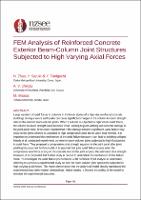| dc.contributor.author | Zhao, Neng | |
| dc.contributor.author | Suzuki, Yusuke | |
| dc.contributor.author | Shegay, Alex | |
| dc.contributor.author | Maeda, Masaki | |
| dc.contributor.author | Taniguchi, Yoshiya | |
| dc.date.accessioned | 2024-07-01T02:01:26Z | |
| dc.date.available | 2024-07-01T02:01:26Z | |
| dc.date.issued | 2024-04-09 | |
| dc.identifier.uri | https://repo.nzsee.org.nz/xmlui/handle/nzsee/2774 | |
| dc.description.abstract | Large variation of axial forces in columns in the lower stories of a high-rise reinforced concrete buildings during a severe earthquake can cause significant changes in the column-to-beam strength ratio in the exterior beam-column joints. When a column is subjected to high tensile axial forces, the column-to-beam strength ratio becomes small, leading to joint yielding and concrete damage in the joint panel zone. It has been reported that if this damage become significant, axial failure may occur in the joints when it is subjected to high compressive axial forces upon load reversal. It is important to understand this mechanism of the axial failure because it can lead to building collapse. Maeda et al. conducted experiments on exterior beam-column joints subjected to high fluctuations in axial force. They proposed a compressive strut strength equation in the joint panel after joint yielding has occurred. In this model, it is assumed that joint axial failure occurs when the compressive axial force acting on the concrete strut in the joint exceeds the estimated strut strength. However, it is concluded that further study is needed to understand the mechanism of this failure mode. To investigate the axial failure phenomenon, a 3D nonlinear FEM analysis is undertaken, referring to a previous experimental study on exterior beam-column joint specimens subjected to high varying axial forces. The results demonstrate that the analytical model closely reproduced the experimental load-deformation relationships, failure modes, and joint shear deformation angles. It showed the ability of the model to simulate the experimental outcomes. | |
| dc.language.iso | en | |
| dc.publisher | New Zealand Society for Earthquake Engineering | |
| dc.relation.ispartofseries | 2024;95 | |
| dc.subject | Seismic performance, risk mitigation and resilience of new and existing structures | |
| dc.title | Finite Element Method Analysis of Reinforced Concrete Exterior Beam-Column Joint Structures Subjected to High Varying Axial Forces | |
| dc.type | Article | |

